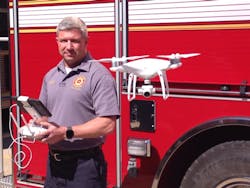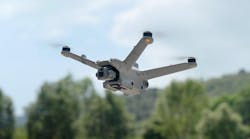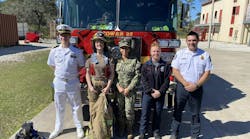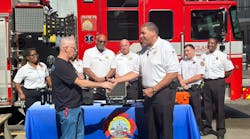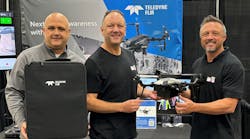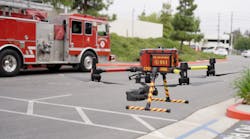The stiff breeze ruffled the flags over the West Memphis, AR, Fire Department's station on Seventh Street, but Lt. Fred Thorne was able to deftly control his DJI Phantom 4 drone as it rose higher into the wind.
Thorne toggled the stick on his controller and the white 8.4-pound drone climbed to 40 feet. Thorne pushed another switch and the drone spun in a circle, providing a 360-degree view of the neighborhood near the fire station on a video screen mounted above the controller. The drone's camera captured cars as they zipped along Broadway Street by the station and firefighters who stood gawking up at the aircraft.
The drone headed north toward Interstate 40 near its merger with Interstate 55 just west of the Mississippi River—the third busiest interstate exchange in the country—before returning to land softly on the fire station's parking lot.
“This is going to be great,” Thorne said. “This is going to be a beneficial tool for our fire department.”
Game-changing technology
The West Memphis Fire Department is one of a growing number of fire departments across the United States to use a drone as a firefighting tool. The New York City Fire Department bought several drones last September to use when responding to two-alarm or larger fires. The North Stonington, CT, Fire Department recently began using their aircraft devices, along with fire departments in San Diego; Gulfport, MS.; Naperville, IL.; Joshua, TX; and Valley Township, PA, to name a few. It is also the only Arkansas fire department to use a drone, said Rusty McClain, president of the Arkansas State Firefighters Association.
Deputies at the Oauchita County Sheriff's Office in western Arkansas began using a drone two years ago to assess damage when a tornado ripped through Bearden in the northeastern edge of the county in December 2015.
“It gives you a bird’s-eye view,” Captain Adam LaDuke said. “You can see everything better. We could see the storm's path. It knocked hours off of work.”
The sheriff's office also uses the drone when deputies serve warrants. Last year, deputies prepared to arrest a person who lived on a dead-end road when they received a tip that the person had weapons in his home.
"It was a high-risk search warrant,” LaDuke said. “They could see us coming down the road.”
Deputies launched the drone and watched as it flew over the suspect's home. At one point, the man stepped outside, saw the drone and shot it out of the air, which was captured on the craft's camera and later shown on the Internet.
“We were 30 seconds from pulling into his driveway,” LaDuke said. “The drone changed our approach. It could have been a bad situation.”
Saving time and money
The West Memphis Fire Department initially looked into purchasing the drone to save on costly overtime expenses. Paying firefighters overtime expenses put a burden on municipalities—especially those smaller towns—in tough economic times.
But the true catalyst for obtaining the drone was a Jan. 31, 2017, crash involving a tractor-trailer carrying hazardous materials on Interstate 40 in West Memphis, Thorne said.
The rig's trailer was loaded with sodium cyanide. It flipped on the interstate early that morning, forcing the closure of the westbound lanes. The turned over trailer lay near water, which reacts explosively with the volatile chemical.
Because of the dangerous situation, West Memphis firefighters put on their hazmat protection gear and slowly approached the scene to assess the situation. Thorne said because of a poor vantage point and the inability to see the wreckage, it took over an hour for firefighters to contain the scene and ensure the spilled chemical would not explode.
“Obviously, we had to be careful,” he said. “We had to be sure to know what we were dealing with before we sent anyone in.”
It would have been different, he said, had the department used its drone then.
"We could have gotten the drone up and on the scene in 5 minutes,” Thorne said. “We didn't know what level of response we needed at first.”
The overtime expenses of firefighters costs the city about $1,000 that day, Thorne said. The Phantom 4 drone cost $1,400.
“It would pay for itself within a couple of runs,” he said. “I was a drone salesman when I asked the City Council to approve buying one.”
Paperwork first
The department hasn't used the drone at an actual scene yet, Thorne said. He is in the process of obtaining a certificate of authorization (COA) from the Federal Aviation Administration (FAA), which will allow him to teach other firefighters how to use it. Throne said he wants to teach 12 firefighters so the drone can be used on each of the West Memphis department’s three shifts.
The FAA has strict regulations for government entities to fly drones. Civilians can buy the crafts and fly them minutes after taking them out of the box; however, firefighters, law enforcement officers, rescue workers and other governmental employees must take extensive tests for certification.
One federal rule is that devices cannot fly above 400 feet or in any restricted air space around airports. Memphis International Airport is within 15 miles of the West Memphis Fire Department. If the department's drone gets too close to the airport or an airplane, it automatically shuts down and lands.
Adopting something new
Thorne hopes to employ the drone by July. In the meantime, he's letting other firefighters practice with the drone at the station, helping the older ones quell resistances to the new technology.
“We have some old-school guys who first were opposed to the idea,” Thorne said. “Some of the older guys may be set in their ways, and it's hard to bring new technology in. But once they see it, they jump on board.”
Thorne said once firefighters see how easy it is to operate the drone, and view the extremely clear pictures on the monitor's screens, they begin accepting the new tool.
Thorne said it was easier than he thought it would be to eliminate any of the firefighters' objections to the use of a drone.
“They can see the benefits,” he said. “We can use it for hazmat situations, for search and rescues, missing children, any kind of thing. We can also shoot training video of working fires. This is an extra tool in our truck. With this, we can cover a lot of ground. We can save time and lives.”
